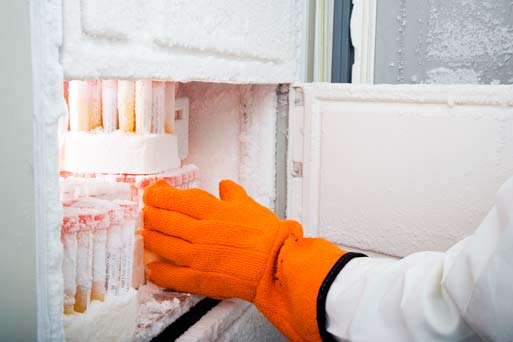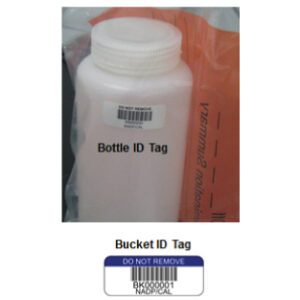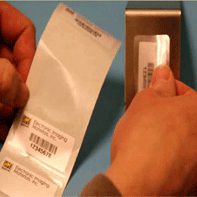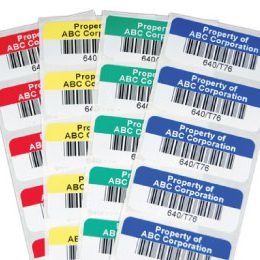n any research or clinical environment, proper sample identification can be the difference between groundbreaking discoveries and months of setbacks. Yet standard labels often don’t stand a chance in ultra-cold freezers, let alone in liquid nitrogen storage. That’s why frozen tube labels have become indispensable in modern laboratories. Designed to tolerate temperatures reaching as low as -196°C, these specialized labels maintain adhesion, remain legible, and ensure that even after multiple freeze-thaw cycles, each vial tells the right story. In this guide, we’ll explore why frozen tube labeling is essential, how to identify the right label features, and what best practices help keep your lab running smoothly.

Why Frozen Tube Labels Differ From Regular Labels
Regular paper stickers may suffice for room-temperature test tubes or short-term storage, but cryogenic conditions quickly expose their limitations. When tubes are routinely plunged into liquid nitrogen or cycled between cold freezers and incubators, adhesives can freeze, crack, or peel away, causing identification failures that compromise entire experiments.
Unlike standard options, frozen tube labels use adhesives and facestocks engineered specifically for sub-zero temperatures. Their structure ensures they hold firmly to plastic or glass surfaces—even when those surfaces gather frost or condensation. Additionally, the print surfaces on high-quality labels are formulated to maintain text clarity and barcode scannability, preventing data errors over time.
Key takeaways include:
- Cryogenic adhesives remain tacky in ultra-cold environments.
- Synthetic topcoats protect against moisture, scratches, and chemical solvents.
- Strong bonding power helps labels hold on through repeated freeze-thaw cycles.
The Significance of Accuracy and Reliability in Sample Tracking
Accurate sample identification isn’t just about convenience—it’s about the core integrity of scientific work. In many fields, from genomic research to clinical diagnostics, losing a single vial’s data can undermine an entire study or delay important patient results. Reliable labeling also supports compliance with regulatory standards and helps labs uphold robust quality control measures.
Consistency in laboratory labeling also speeds up daily tasks. When staff members can confidently read or scan each label, they spend less time troubleshooting mislabeled samples or rechecking inventory records. This clarity fosters an environment of trust and accountability where each step of the process, from sample collection to disposal, is meticulously documented and verifiable.
The top benefits of reliable labeling include:
- Minimizes risk of mix-ups or contamination.
- Ensures compliance with regulations that require traceable sample histories.
- Boosts overall productivity, freeing up personnel for high-level tasks.
Features of High-Quality Frozen Tube Labels
To handle the rigors of cryogenic storage, premium frozen tube labels rely on innovative adhesives, robust facestocks, and specialized topcoats. Two standout solutions—686 White CryoLabel® Frost and 687 Clear CryoLabel® Frost Polyester—demonstrate how these features come together to support accuracy and reliability.
3.1 686 White CryoLabel® Frost
Thin, flexible, and perfectly suited for small-diameter test tubes, 686 White CryoLabel® Frost is built for environments where space is tight and durability is a must. Its glossy topcoat ensures excellent print quality, especially when paired with resin-based thermal transfer ribbons. Some important traits include:
- Outstanding Water, Scratch, and Chemical Resistance: Ideal for labs that perform daily tube handling or chemical processes.
- Strong Adhesive for Cold Surfaces: Will stick to frosty surfaces and maintain a secure bond on a variety of materials, including polypropylene, polyethylene, polycarbonate, and glass.
- Versatility for Extreme Conditions: Works in freezers and liquid nitrogen storage, endures freeze-to-boiling-water cycles, and even withstands autoclave processes up to 121°C with saturated steam for 30 minutes.
This multipurpose label stays put on frozen containers—even with light to moderate frost—and recovers well if tubes are removed from ultra-low temperatures and reintroduced to warm environments.
3.2 687 Clear CryoLabel® Frost Polyester
When visibility matters, 687 Clear CryoLabel® Frost Polyester steps up to the plate. Offering a transparent finish, it’s perfect for labs that need to easily see vial contents without removing or peering around the label. Like its White counterpart, it boasts a thin, flexible construction with:
- Smooth, Glossy Topcoat: Ensures crisp print resolution for barcodes and text.
- Durable Adhesive: Sticks firmly to polypropylene, polyethylene, glass, pre-frozen surfaces, and metal under low temperatures.
- High Resistance to Wear and Tear: Maintains integrity through autoclaving, freeze-to-boiling cycles, and repeated handling.
- Wrap-Around Applications: The clear design suits wrap-around label strategies that laminate printed information for extra protection.
Because the 687 Clear CryoLabel® is so thin, specialized die tooling might be needed. However, the trade-off is unmatched clarity and minimal interference with your view of the tube contents.
Why Cryogenic Labels Demand Higher Standards
One of the biggest misconceptions about cryogenic labels is that any label that “sticks” will suffice. In reality, these labels must endure some of the harshest conditions in the lab. From repeated immersion in liquid nitrogen to abrupt freeze-thaw cycles, labels can be tested in every imaginable scenario.
“Good enough” is rarely actually good enough. For accurate results and efficient workflows, a label specifically designed for cryogenic storage—like frozen tube labels—is essential.
- Low-Temp Adhesion: The adhesive has to activate and hold firm at ultra-low temperatures.
- Physical Durability: Frequent handling, scanning, and rack placement can cause friction that easily wears down inferior labels.
- Moisture Resistance: Frost and condensation accumulate rapidly when samples move from cold to warm environments, risking label lift or ink smearing.
- Chemical Compatibility: Labs often use disinfectants, solvents, and other chemicals that can degrade standard sticker materials.
Selecting the Right Barcode Labels for Frozen Samples
Choosing the proper label often goes beyond material selection. In modern labs, adding barcodes offers significant improvements in tracking and data management. Barcode labels for frozen samples ensure quick scans, whether for inventory checks or data logging. Pairing robust cryogenic facestocks with high-quality thermal transfer ribbons helps labs to seamlessly integrate barcodes without worrying about fading or smudging.
Key considerations include:
- Print Method: Thermal transfer with a resin ribbon is often the gold standard for cryogenic labeling.
- Data Capacity: 1D codes (e.g., Code 128) may be sufficient for simple alphanumeric data, while 2D codes (e.g., DataMatrix) store more complex information in a smaller footprint.
- Label Size and Placement: Decide whether a wrap-around style suits your needs or if you need a transparent section to see the sample directly.
- Software Integration: Ensure your LIMS (Laboratory Information Management System) or inventory software can efficiently read and record data from the barcodes, minimizing manual entries.
If you’re ready to reduce label failures and improve overall sample management, reach out to our team for tailored solutions. We’ll help you select from our range of cryogenic labels, ensure optimal adhesion under extreme conditions, and integrate the right barcode strategies for smooth, hassle-free laboratory labeling.
Best Practices for Applying and Maintaining Frozen Tube Labels
No matter how durable your labels may be, proper application and maintenance can make all the difference. Follow these tips to get the most out of your frozen tube labels:
- Surface Prep: If possible, allow tubes to warm slightly so condensation evaporates. Any frost or moisture acts as a barrier between the adhesive and tube surface.
- Press Firmly: Apply consistent pressure for a few seconds. This is especially important for thin materials like 687 Clear CryoLabel® Frost Polyester.
- Avoid Touching the Adhesive: Oils from your hands can weaken the adhesive bond. Handle labels by the edges whenever you can.
- Use Resin Ribbons for Printing: Resin-based thermal transfer ribbons offer better resistance to chemicals, temperature fluctuations, and friction than wax or wax-resin options.
- Perform Routine Checks: If your samples undergo multiple freeze-thaw cycles, it’s good practice to spot-check the label condition. Look for signs of peeling, fading, or cracking.
Ensuring Consistent Results Across Freeze-Thaw Cycles
Cryogenic labels from product lines like 686 White CryoLabel® Frost and 687 Clear CryoLabel® Frost Polyester are tested for extremes—not just in cold storage, but also in cycles that involve transitions to warmer environments. They can handle LN2 for 30 minutes, followed by boiling water at 100°C for 10 minutes, or survive repeated freeze-to-incubator intervals. Such resilience ensures that even if your workflow calls for ongoing temperature shifts, your labeling remains intact.
Consistent adhesion over time also reduces the workload of re-labeling. This long-term reliability helps labs maintain cohesive records, keep track of expiration dates, and easily identify exact tube contents, even after months of storage.
Take Your Laboratory Labeling to the Next Level with Electronic Imaging Materials
We’re committed to helping you master frozen tube labels so you can safeguard vital research and clinical data. Whether you prefer our 686 White CryoLabel® Frost for color-coding or the 687 Clear CryoLabel® Frost Polyester to maintain visual access to tube contents, our products are engineered to handle the toughest conditions in modern labs.
Ready to eliminate the risk of peeling, smudging, or lost sample data? Reach out to EIM and discover the transformative difference our cryogenic labels can make in your lab’s accuracy, compliance, and overall success.




